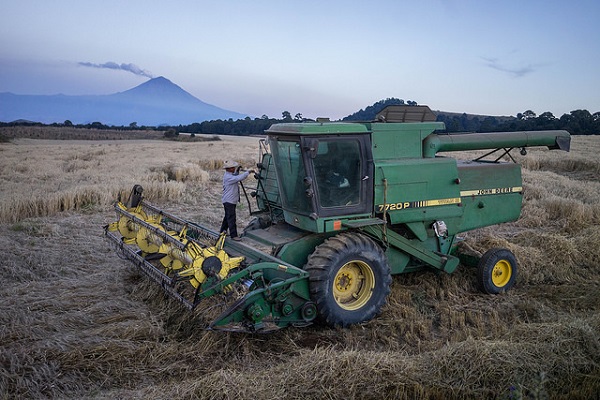
MEXICO CITY (CIMMYT) – Traditionally, agricultural research organizations measured impact by the number of technologies developed, with less attention given to whether or not these technologies were adopted by farmers and the impact they had in communities.
Today organizations must clearly demonstrate impact in farmers’ fields. Research and extension approaches based on agricultural innovation systems, or networks of organizations within an economic system that are directly involved in the creation, diffusion and use of scientific and technological knowledge, as well as the organizations responsible for the coordination and support of these processes.
This shift represents a new focus on innovation as a social process, as opposed to a research-driven process of technology transfer.
Despite growing interest in agricultural innovation system, little is still known about the most effective ways to operationalize these systems, especially within short and medium timeframes, according to researchers from the International Maize and Wheat Improvement Center (CIMMYT) in a new paper “Agricultural research organisations’ role in the emergence of agricultural innovation systems.”
The study claims that external input is often needed to generate an agricultural innovation system, and that network brokers – actors like NGOs and others, who catalyze collective action by enhancing farmers’ access to information and technical assistance – play a crucial role.
The authors conclude that while scientific research is an important component of the development of an agricultural innovation system, it is not enough; more emphasis has to be directed at extension and education of different actors to achieve a genuine paradigm shift in agricultural innovation.
Read the full study here and check out other recent publications from CIMMYT staff below.
- Agricultural research organisations’ role in the emergence of agricultural innovation systems. 2017. Hellin, J.; Camacho Villa, T.C. Development in Practice 27 (1) ; 111-115.
- Evaluation of the APSIM model in cropping systems of Asia. 2017. Gaydon, D.S.; Singh, B.; Wang, E.; Poulton, P.L.; Ahmad, B.; Ahmed, F.; Akhter, S.; Ali, I.; Amarasingha, R.; Chaki, A.K.; Chen, C.; Choudhury, B.U.; Darai, R.; Das, A.; Hochman, Z.; Horan, H.; Hosang, E.Y.; Vijaya Kumar, P.; Khan, A.S.M.M.R.; Laing, A.M.; Liu, L.; Malaviachichi, M.A.P.W.K.; Mohapatra, K.P.; Muttaleb, M.A.; Power, B.; Radanielson, A.M.; Rai, G.S.; Rashid, M.H.; Rathanayake, W.M.U.K.; Sarker, M.M.R.; Sena, D.R.; Shamim, M.; Subash, N.; Suriadi, A.; Suriyagoda, L.D.B.; Wang, G.; Wang, J.; Yadav, R.K.; Roth, C.H. Field Crops Research 204 : 52-75.
- Forward genetics by sequencing EMS variation induced inbred lines. 2017. Addo-Quaye, C.; Buescher, E.; Best, N.; Chaikam, V.; Baxter, I.; Dilkes, B.P. G3 7 (2) : 413-425.
- Genetic analysis and mapping of adult plant resistance loci to leaf rust in durum wheat cultivar Bairds. 2017. Caixia Lan; Basnet, B.R.; Singh, R.P.; Huerta-Espino, J.; Herrera-Foessel, S.; Yong Ren; Randhawa, M.S. Theoretical and Applied Genetics 130 (3) : 609–619.
- Genotype by trait biplot analysis to study associations and profiles of Ethiopian white lupin (Lupinus albus) landraces. 2017. Atnaf, M.; Kassahun Tesfaye; Kifle Dagne; Dagne Wegary Gissa. Australian Journal of Crop Science 11 (1) : 55-62.
- Application of remote sensing to identify adult plant resistance loci to stripe rust in two bread wheat mapping populations. 2016. Pretorius, Z.A.; Caixia Lan; Prins, R.; Knight, V.; McLaren, N.W.; Singh, R.P.; Bender, C.; Kloppers, F.J. Precision Agriculture. Online First.
- Genomic prediction models for grain yield of spring bread wheat in diverse agro-ecological zones. 2016. Saint Pierre, C.; Burgueño, J.; Crossa, J.; Fuentes Dávila, G.; Figueroa López, P.; Solís Moya, E.; Ireta Moreno, J.; Hernández Muela, V.M.; Zamora Villa, V.; Vikram, P.; Mathews, K.; Sansaloni, C.P.; Sehgal, D.; Jarquín, D.; Wenzl, P.; Sukhwinder-Singh. Nature Scientific reports 6 : 27312.
- Genomic prediction using phenotypes from pedigreed lines with no marker data. 2016. Ashraf, B.; Edriss, V.; Akdemir, D.; Autrique, E.; Bonnett, D.G.; Crossa, J.; Janss, L.; Singh, R.P.; Jannink, J.L. Crop Science 56 (3) : 957-964.
- Identification of genomic associations for adult plant resistance in the background of popular South Asian wheat cultivar, PBW343. 2016. Huihui Li; Sukhwinder-Singh; Bhavani, S.; Singh, R.P.; Sehgal, D.; Basnet, B.R.; Vikram, P.; Burgueño, J.; Huerta-Espino, J. Frontiers in Plant Science 7 (1674) : 1-18.
- Mapping of spot blotch disease resistance using NDVI as a substitute to visual observation in wheat (Triticum aestivum L.). 2016. Suneel Kumar; Roder, M.S.; Singh, R.P.; Kumar, S.; Ramesh Chand; Joshi, A.K.; Kumar, U. Molecular Breeding 36 (95) : 1-11.
 Nutrition, health and food security
Nutrition, health and food security 
